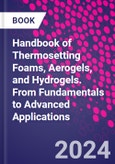Handbook of Thermosetting Foams, Aerogels, and Hydrogels: From Fundamentals to Advanced Applications presents the latest knowledge on the preparation, characterization, properties, and applications of thermoset foams, aerogels, and hydrogels.
This book begins by introducing thermoset foams, aerogels, and hydrogels, their characteristics, current applications, potential for further development, and environmental impact. This is followed by three sections, each focusing on foams, aerogels, and hydrogels developed from a specifi c thermosetting polymer category, covering polyurethane, epoxy resins, and formaldehyde. In each section, detailed coverage guides the reader through the preparation, structure, characterization, properties, processing, and applications of foams, aerogels, and hydrogels based on that material, as well as addressing key challenges in terms of design, processing, and implementation, and possible solutions.
This is a valuable resource for researchers and advanced students with an interest in thermoset lightweight materials, across the disciplines of polymer science, chemistry, nanotechnology, materials science, and engineering. This is also of interest to R&D professionals, engineers, and scientists working with foams, hydrogels, and aerogels for a range of applications and industries.
Please Note: This is an On Demand product, delivery may take up to 11 working days after payment has been received.
Table of Contents
Section I: Introduction1. Foams, aerogels and hydrogels: The state of the art and prospective technologies.
2. Opportunities and versatile applications of thermoset foams, aerogels, and hydrogels: Current state of the art and anticipated developments
3. Environmental impact and recycling technologies of thermoset resin, foams, aerogels and hydrogels
Section II: Polyurethane-based Foams, Aerogels, and Hydrogels
4. Polyurethane (PU): Structure, properties, and applications
5. Polyurethane foam: The foaming process and the effect of process parameters on properties
6. Polyurethane nanocomposite foams: Preparation, properties and applications
7. Polyurethane based hydrogels synthesis, properties, and modifications
8. Polyurethane-based aerogels: Preparation, properties, and applications
9. Polyurethane-based foam and aerogels for automotive and aerospace applications
9. Shape memory polyurethane-based foams and aerogels
10. Challenges in design, processing and use of PU foam/aerogel materials
Section III: Epoxy-based foams, aerogels, and hydrogels
11. Epoxy resins: Synthesis, structure, and properties
12. Epoxy-based hydrogels: Network design, characterization, and applications
13. Epoxy: Foaming processes and the effect of process parameters on properties of epoxy foam
14. Epoxy foams reinforcing with nanomaterials: Synthesis, mechanical properties and applications
15. Shape memory epoxy foam-defense and aerospace applications
Section IV: Formaldehyde-based foams, aerogels, and hydrogels
16. Phenolic resin: Preparation, structure, properties, and applications
17. Phenolic foams: Foaming processes and applications
18. Phenolic foams: Structure-property relationships and insulating properties
19. Phenolic aerogels: Preparation, properties, and applications
20. Phenolic foams reinforced with nanomaterials: Preparation, properties, and applications
21. Melamine-formaldehyde hydrogels, foams, and aerogels: Preparation, properties and applications
22. Urea formaldehyde foams, aerogels and hydrogels: Preparation, properties and applications
23. Carbon foams derived from thermosetting polymers: Preparation, properties and applications
24. Carbon foams derived from phenol and melamine formaldehyde thermosetting polymers: Preparation, properties, and applications
25. Carbon foams derived from thermosetting epoxy, polyimides and cellulosic polymers: Environmental and electrical or electrochemical applications








